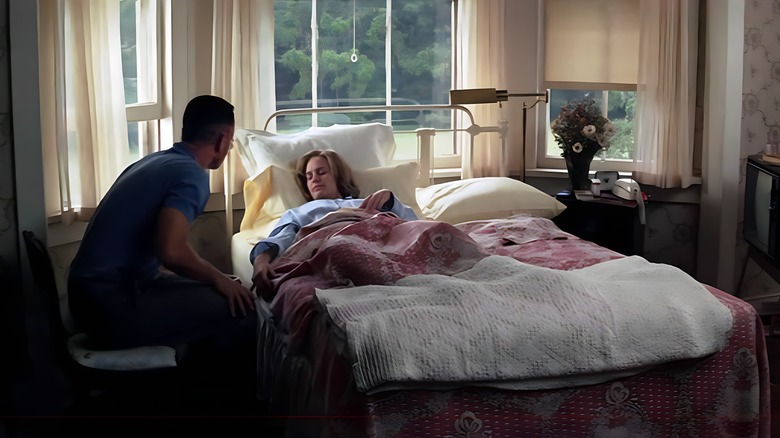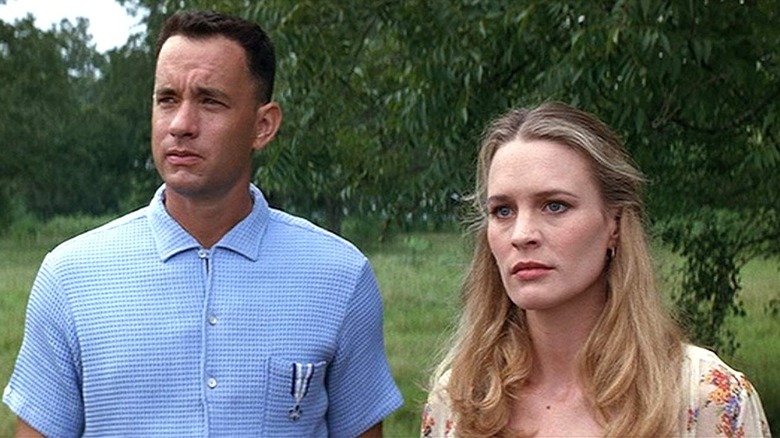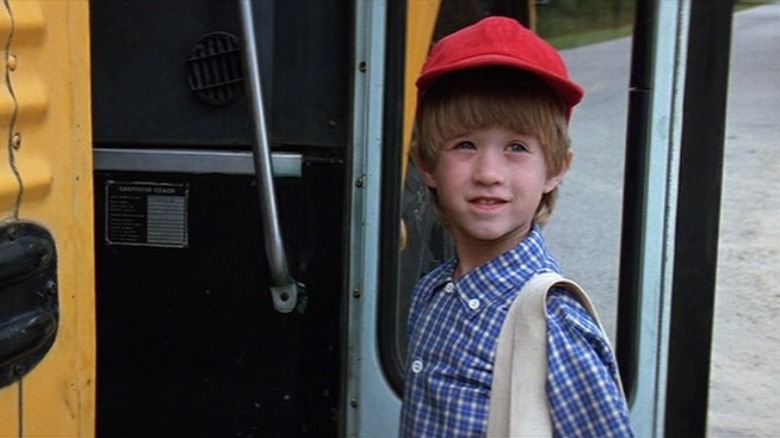The Final Moments Of Jenny In Forrest Gump, And What They Mean
Robert Zemeckis' 1994 Oscar darling "Forrest Gump" is a preachy, mawkish glob of syrupy sputum hocked from the throat of conservative America right into the face of the more daring, queer, artistically ambitious indie fare coming to the fore at the same time. It tells the story of a mentally disadvantaged man (Tom Hanks) who leans unthinkingly into every traditional trope of regressive Americana and meets nothing but success and fame. Forrest Gump is good at running and becomes a high school football star. He serves in the army and becomes a hero. He is very good at table tennis and becomes an Olympic champion. He tries his hand at small business — shrimping — and succeeds. He has an IQ of 75 and becomes a billionaire by following the rules.
Meanwhile, the characters who express any sort of malcontentedness with The System are punished. Notably, Jenny (Robin Wright), Forrest's childhood love, hits the road to become a hippie and perform music. She started life as a victim of domestic abuse and grows to want to make art and express her sexuality more openly. The movie depicts her journey as a gradual degradation leading to nude performances and an itinerant, unhappy life. Abuse, sex, unhappiness, and a woman's self-expression, the film seems to say, aren't compatible with the American Dream. Eventually, Jenny returns to Forrest only to die of an unnamed ailment. Given the film's time frame, many audiences assumed she had contracted HIV or AIDS.
In the original Winston Groom novel, Jenny dies of hepatitis C, discovered in 1989. In the film, written by Eric Roth, Jenny died on March 22, 1982.
It wasn't until an interview with Yahoo! News in 2019 that Roth clarified that, yes, in the film, Jenny did indeed die of AIDS.
The curse of the free woman
Jenny's AIDS diagnosis was confirmed in a planned sequel to "Forrest Gump" that would have brought the character up to the 1990s. Throughout "Gump," the character unwittingly stumbled into various notable historic events and unwittingly invented small pieces of Americana the audience can chuckle at. He met multiple presidents, gave Elvis Presley the idea to shake his hips, and penned the phrase "s*** happens." The sequel would take a similar approach, putting Forrest at a dance competition with Princess Diana, and, in a truly bizarre idea, on the roof of O.J. Simpson's white Bronco during his infamous 1994 chase. It's notable that Zemeckis' original film was released in L.A. theaters the week after the Simpson chase.
Roth also said that the film would have been more of a tragedy, beginning and ending with unbearably sad events. At the end, for instance, Forrest would be left obliviously waiting for a Native American friend who had just been killed in the Oklahoma City bombings. And at the beginning, Forrest, Jr., played in the original film by Haley Joel Osment, would be diagnosed with AIDS, having caught it from his mother. Roth's grim tale, it seems, was meant to feel like a bleak satire of the original. He said:
"It was gonna start with his little boy having AIDS. [...] And people wouldn't go to class with him in Florida. We had a funny sequence where they were [desegregation] busing in Florida at the same time, so people were angry about either the busing or [their] kids having to go to school with the kid who had AIDS. So there was a big conflict."
It seems that Roth wanted to mock the kind of conservatism that the first filmed so heartily endorsed.
Little Forrest
Winston Groom, one might remember, already wrote a sequel to his original 1986 novel called "Gump & Co.," which was published in 1995. Groom's sequel was far more upbeat, although it followed a similar pattern to the original by putting Forrest into several notable events in American history. At the start of the book, Forrest loses his shrimp company and his fortunes dry up, forcing him to start at the bottom and earn money for his son. He goes on a military mission for Ronald Reagan and meets Ayatollah Khomeini, he exposes Jim Bakker's affair, and hangs out with John Hinckley, Jr. In a cute twist, Forrest meets the movie star Tom Hanks, who does not impress him. The implication in "Gump & Co." is that Zemeckis' film didn't get Gump's actual life entirely right.
Forrest also instigates the fall of the Berlin Wall, fights in the Iraq war, and meets the Clintons. The book ends with someone wanting to adapt Gump's life into another movie.
Roth's vision took a similar approach to Groom's, albeit much darker. Any sort of "Forrest Gump" movie sequel was, however, squelched by 9/11. The public violence made the insertion of Forrest Gump into other violent terrorist events less amusing. The project was canceled and has been dead ever since.
It sounds, though, like Roth's sequel would have turned the tables on Forrest. Rather than be a well-meaning dope whose blind adherence to America's conservative institutions rewarded him, he was to be punished by his idiocy in the time of Generation X. A new ethos would creep into the country that no longer rewarded dopes, and saw fame transform into infamy. In the sequel, it seems Jenny would have found treatment, survived, and been happy.
Perhaps she was born before her time.


